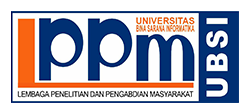Effect of Inflation, BI Rate And Net Export To USD Central Exchange Rate to Rupiahs In Bank Indonesia For 2005-2019
Abstract
Full Text:
PDFReferences
A. Muri, Y. (2017). Metode Penelitian: Kuantitatif, Kualitatif Dan Penelitian Gabungan. Kencana (Vol. 16). Jakarta.
Bank Indonesia. (2016). BI Rate. Retrieved from https://www.bi.go.id/id/statistik/metadata/seki/Documents/8_Suku_Bunga_Indo_DPM SEKI_2016 (Indonesia) new.pdf
Bps.go.id. (2021). Produk Domestik Bruto (Lapangan Usaha). Retrieved from https://www.bps.go.id/subject/11/produk-domestik-bruto--lapangan-usaha-.html#subjekViewTab1
Harjunawati, S & Hendarsih, I. (2018). HUBUNGAN PRODUK DOMESTIK BRUTO DAN JUMLAH UANG BEREDAR TERHADAP INFLASI DI INDONESIA 2005-2017. MANAJERIAL. Penelitian Ilmu Manajemen, 1.1, 121–130.
Harjunawati, S & Hendarsih, I. (2020). PENGARUH PENGANGGURAN DAN INFLASI TERHADAP PRODUK DOMESTIK BRUTO INDONESIA TAHUN 2009-2019. Pendidikan Dan Kewirausahaan, 7.2, 13–24. Retrieved from https://doi.org/10.1017/CBO9781107415324.004
Irungu, E. N. (2017). Factors that in uence volatility in the Foreign Exchange Rate in Kenya. United States International University - Africa. Nairobi. Retrieved from http://erepo.usiu.ac.ke/bitstream/handle/11732/3326/EMILY NJOKI IRUNGU MBA 2017.pdf?isAllowed=y&sequence=1
Ismanto, B. Rina, L & Kristini, M. A. (2019). Pengaruh Kurs dan Impor Terhadap Pertumbuhan Ekonomi Indonesia Periode Tahun 2007-2017. Jurnal Universitas Kristen Satya Wacana, 2.1, 1–6. Retrieved from https://ejournal.uksw.edu/ecodunamika/article/view/2279
Prasetyanwar, H. (2018). Peramalan Nilai Tukar IDR-USD Menggunakan Long Short Term Memory, 5.2.
Pratama, I.,& Tjun Tjun, L. (2018). Pengaruh Suku Bunga Acuan dan Nilai Kurs Tengah Valuta Asing Terhadap Return Saham. Akuntansi Maranatha, 9.2, 180–185. Retrieved from file:///C:/Users/Acer/Downloads/486-Article Text-613-1-10-20180119.pdf
Purba & Magdalena, A. (2017). Pengaruh Nilai Tukar Terhadap Ekspor dan Dampaknya Terhadap Pertumbuhan Ekonomi Indonesia. DeReMa Jurnal Manajemen, 12.2, 285–295.
Sukirno, S. (2016). Makroekonomi: teori pengantar. (R. Pers, Ed.) (3rd ed.). Jakarta.
DOI: https://doi.org/10.31294/moneter.v8i1.10338
Index by:
dipublikasikan oleh LPPM Universitas Bina Sarana Informatika dengan dukungan Relawan Jurnal Indonesia
Jl. Kramat Raya No.98, Kwitang, Kec. Senen, Kota Jakarta Pusat, DKI Jakarta 10450

This work is licensed under a Creative Commons Attribution-ShareAlike 4.0 International License






